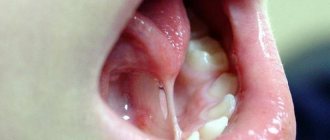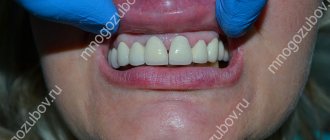Reasons for the appearance of a lump
A tumor can appear for various reasons. If the pain is not severe, temporary, and goes away on its own within a day, there is nothing to worry about. And when the appearance of a growth causes significant discomfort and lasts for several days, you should be alarmed. A growth under the tongue near the frenulum can be caused by the following factors:
- Condylomatosis, that is, papilloma virus. In this situation, the cell growth mechanism is disrupted. The early phases of the disease have no obvious symptoms. The virus is actively transmitted through household and sexual contact, especially with weak immunity. The nature of warts is such that they act selectively. HPV is distinguished by genotypes. There are benign and life-threatening strains. Warts may rise above the muscular organ. Keratin, which is produced in such cells, gives the balls rigidity.
- Inflammation often appears when the frenulum is short from birth. It is better to correct the problem in childhood.
- The process of inflammation appears with vitamin deficiency, gastrointestinal diseases, allergies, abscesses in the oral cavity, and injuries.
- A pimple on the frenulum under the tongue is formed during tonsillitis, when streptococci and staphylococci are activated and the lymph nodes are affected.
- The problem occurs when the salivary duct is blocked. Mineral or mucus plugs can become an obstacle. This interferes with patency. In this situation, a ranula is formed, which contains liquid exudate. The bubble may be clear or cloudy. It can burst, then build up again. Provoking factors include stomatitis, herpes, candidiasis, and lichen planus.
Since the mucous tissues of the oral cavity are sensitive, they can be damaged by hot food or drink. In the burn area, bacterial microflora feels comfortable, which contributes to the formation of salivary plugs in the ducts.
Drug treatment
To eliminate growths under the tongue with condylomatosis, complex treatment is used, which includes:
- taking antiviral drugs;
- the use of antiseptic solutions and ointments for local treatment of the affected area;
- carrying out complete sanitation of the oral cavity at the dentist (treatment of caries, inflammation of dentin, and other problems);
- consumption of a vitamin complex to strengthen the body’s protective functions;
- taking immunomodulatory drugs;
- removal of growths using surgery, a laser beam or radio waves.
During the period of therapy, it is important to reconsider your usual lifestyle and make adjustments to it, getting rid of bad habits and casual relationships. To speed up the healing process, you need to avoid irritating the mucous membranes with hot or too cold drinks and dishes. Hygiene procedures should be carried out regularly, at least 2 times a day, using high-quality cleaning products.
Popular antiviral drugs include:
- Acyclovir (tablets);
- Panavir (solution for intravenous injection);
- Isoprinosine (tablets);
- Allokin-Alpha;
- Alpizarin (tablets).
The following are considered effective immunomodulators: Derinat, Likopid, Immunomax, Polyoxidonium.
For local impact on the lesion, the following means are used:
- Podophyllin;
- Cryopharma;
- Lapis pencil;
- Solcoderm;
- Verrukacid et al.
When using local preparations, you need to carefully read the instructions so that during the treatment of papillomas you do not burn healthy mucosal tissue.
Which doctor should I contact?
If a lump appears under the tongue on the frenulum, you need to find out what factors provoked its formation. Only a doctor can correctly determine the cause. After all, the ball can be filled with liquid or consist of epithelial cells. The degree of discomfort depends on the size of the formation. When papillomas are soft, the patient may not feel them, but large inflammatory growths interfere and begin to hurt. Contact your doctor if you experience any of the following symptoms:
- The mucous tissues of the oral cavity constantly dry out;
- The deficiency of saliva and its composition is clearly expressed;
- The taste sensations have changed a lot;
- Increasing pain appeared;
- Swelling on the face increases;
The affected tissue around the lesion may become red and begin to bleed. First of all, you should consult with your local therapist. To confirm the suspected diagnosis, it is most often necessary to visit a dermatologist, dentist, otolaryngologist, venereologist, or gastroenterologist. If the need arises, the patient is referred to a surgeon or oncologist. During the examination, the doctor collects anamnesis, conducts a thorough examination, and performs laboratory diagnostics and histology. In complex cases with abscesses, patients are referred for ultrasound examination, as well as computed tomography. The pathogen is detected using a cytological analysis of saliva.
Causes
The presence of a ranula under the tongue indicates a formed cyst; this pathology is common, and various factors can cause its development. This indicates a disruption in the release of salivary fluid.
When the outlet narrows, secretion is produced, but cannot be excreted in full, this leads to the development of an inflammatory reaction, and in more advanced stages, saliva may not be released at all.
A narrowing of the opening can occur due to a plug (stone), caused by injury, or due to thickening of the salivary fluid or a change in its composition. A characteristic feature of the disease is that in the absence of necessary therapy, the cyst tends to gradually grow, causing increasing discomfort to the patient; in addition, the risk of complications increases.
What could be a growth on the gum?
The following factors can lead to decreased saliva production:
- Pathologies of the mucous membrane of an inflammatory and non-inflammatory nature (oral candidiasis, stomatitis, herpes virus, glossitis and others). These are called primary infections.
- Autoimmune disorders of the mucous membrane - pemphigus, which manifests itself as small blisters, the disease is caused by pathological microflora. In the absence of timely treatment, it often ends in death of the patient.
- A developed tumor that compresses the gland.
- Injury to the mucous membrane - can be caused under various circumstances: a toothbrush, fork or other sharp object, fish bone, teeth, braces and others. This also includes thermal and chemical burns.
- Syphilis is a secondary infection, the appearance of a bubble as a concomitant symptom of the main pathology.
- Serious mechanical trauma - dislocations, fractures of the jaw, which lead to a violation of the integrity of the skin; an infection penetrates through them, causing an inflammatory reaction.
- Lipoma is a benign tumor that is most often localized on the sublingual or posterior zone of the tongue. In appearance they are round or flat. This neoplasm is characterized by an asymptomatic course in the first stages of development and slow growth. As the bladder grows, more and more discomfort occurs because the swelling interferes with speaking and eating. Treatment is carried out surgically.
- Papilloma can form in any area, including the sublingual. The vesicle is lighter in appearance and often painful. The causative agent is the human papillomavirus. It is provoked by a sharp decrease in immunity, which can be caused by drinking alcohol, excessive smoking, psycho-emotional stress and other factors.
- Boil - easily differentiated from other pathologies, since a red lump quickly forms, in the center of which purulent exudate develops. A characteristic feature is severe pain, which subsides after the abscess breaks through. Opening the pathology on your own often leads to infection and blood poisoning.
A number of minor factors are also highlighted:
- Abuse of alcoholic beverages and tobacco products. Exposure to nicotine leads to thinning of the mucous membrane, making it more vulnerable.
- Unhealthy eating.
- The presence of scars on the frenulum of the tongue after surgical interventions.
- Long-term infectious processes at the level of the whole organism.
- Insufficient oral and hand hygiene
- Lack of vitamins in the body.
- Thyroid diseases .
All such factors lead to blockage and narrowing of the passages of the salivary glands; if a cyst is observed, then it is removed surgically.
Treatment and removal methods
The treatment regimen is drawn up depending on what factors caused the anomaly. But treatment is necessary so that the acute stage of the disease does not develop into the chronic phase. If this happens, the exacerbation will recur from time to time. This form of the disease is more difficult to treat. If necessary, laser treatment of gums should be carried out on time. A healthy oral cavity is the key to the overall well-being of the body.
- The doctor selects medications based on the underlying pathology. The initial manifestations of the disease are successfully eliminated with medications and local applications. According to indications, medications are recommended that stimulate saliva production. This may be Galantamine, Pilocarpine, Potassium Iodide. To maintain general condition, the doctor selects means to stimulate the immune system.
- Serious blockage of the salivary glands is eliminated by mechanical cleaning of the ducts. Today, sialoscopy, a minimally invasive procedure for grinding mineral deposits, is widely used.
- Purulent papules are opened, after which the exudate is removed. Surgical technologies such as galvanocaustics, electrocoagulation, cryodestruction, laser beams, and radio waves are used.
- Sanitation of the oral cavity to accelerate the regeneration of damaged tissue includes rinsing with Chlorhexidine, Furacilin, Rotokan, Miramistin.
To prevent pathology, you need to regularly carry out hygiene procedures with a brush and toothpaste. In addition, floss and irrigator should be used. It is necessary to visit the dentist every six months, and other doctors when the initial symptoms of the disease appear.
Symptoms
The symptoms of a neoplasm directly depend on the cause of its occurrence. With any injury, one bubble most often forms, and it may not differ in color from the mucous membrane, sometimes with redness, and an accumulation of blood may be observed - this is a hematoma, it occurs with more severe injuries.
Typically, such blisters do not cause problems with treatment and go away on their own. But with severe injuries with an extensive hematoma, the risk of the development of pathogens with subsequent inflammation increases, since this is a very favorable environment for them.
If the neoplasm has formed as a result of an acute lack of vitamins, then when the diet is normalized and a complex of vitamins is taken, the mucous membrane is restored and the ball disappears. There is no pain syndrome in this case.
For what reasons does a lump appear on the roof of the mouth?
With the development of ranula, a dense capsule is observed, which gradually increases and leads to complications in nutrition and speech function. Diagnosis and surgery are carried out by a specialist.
Pemphigus is characterized by easy peeling under mechanical stress and palpation. When you press on the lump itself, it enlarges, and erosion is observed around the perimeter.
Stomatitis manifests itself in the form of ulcers and redness, while patients complain of pain that intensifies while eating.
Diagnostics
If tongue cancer is suspected, diagnostics include the following:
- a visit to the dentist, during which a specialist will examine the oral cavity and palpate it;
- examination of a smear from the oral cavity (bacterioscopy);
- CT or MRI - to detect metastases in the brain;
- biopsy - examination of a small piece of affected tissue;
- radiography - helps to detect changes in the bones, if any;
- Ultrasound.
Lipoma
Lipoma (wen), a benign connective tissue fatty tumor. The fatty tissue is located on the mucous membrane of the tongue. Divided into two types:
- Patchwork. Flat in shape, has the ability to grow deep into tissues.
- Vulgar. Normal bulge on the tongue.
Lipoma is a soft lump that is completely painless. Slow growth and small size do not cause discomfort in humans. The reasons for education are:
- Heredity.
- Injuries.
- Metabolic disease .
- Unfavorable environmental conditions.
- Bad habits.
If such a formation appears in the mouth, you need to consult a dentist to diagnose the disease.
Treatment
Only a doctor can provide adequate treatment after carrying out the necessary diagnostic measures. Therapy is prescribed based on the causes of occurrence:
- Stomatitis - a course of physiotherapy and treatment of the tumor with antiseptic agents is prescribed. Often, the doctor recommends rinsing the mouth with Rotokan, treating with Stomatidin and sea buckthorn oil. Also suitable for the procedure are decoctions of medicinal herbs such as calendula, chamomile, and oak bark.
- Infection - when this cause is identified, therapy is primarily aimed at eliminating the cause of the disease:
- Herpes - Acyclovir is prescribed.
- Candidiasis - antifungal medications (Clotrimazole, Flucanazole, Flucostat).
- Glossitis - anti-inflammatory and antibiotic medications.
- Syphilis - antibiotics based on Penicillin, Tetracycline.
- Vitamin deficiency – requires nutritional adjustments and taking a complex of vitamins.
- Diseases of the thyroid gland - hormone replacement treatment and iodine-containing drugs are prescribed.
- Cyst-like disorders - surgical removal is prescribed. Local anesthesia is performed, after which cystosialadenectomy is performed - cutting off the cyst. The operation is performed by an experienced surgeon, since there is a high risk of injuring the nerve, which will lead to serious consequences for the patient. After removal, it is necessary to undergo a course of treatment with antibacterial and anti-inflammatory drugs.










